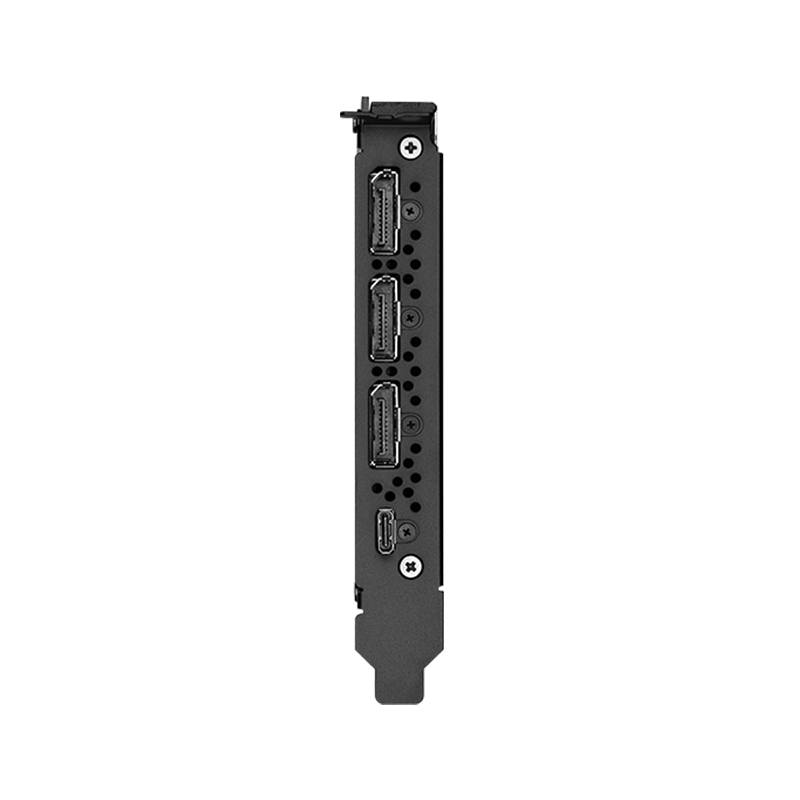Leadtek Quadro RTX 4000 8GB GDDR6 Workstation Graphics Card
Out of Stock
Warranty and Support
Warranty and Support
Warranty: 3 Years Return to Base Warranty
Returns: 14-day hassle-free exchanges and store credits, subject to terms and conditions outlined in our Returns Policy.
Description
Description
Real Time Means Real Change
Meet today’s demanding professional workflows with GPU accelerated ray tracing, deep learning, and advanced shading. The NVIDIA® Quadro RTX™ 4000, powered by the NVIDIA Turing™ architecture and the NVIDIA RTX™ platform, delivers best in-class performance and features in a single-slot PCI-e form factor. Design and create like never before with faster time to insight and faster time to solution.
Built for Professionals
The Quadro RTX 4000 is designed, built, and tested for demanding professional visual computing workflows. Validated in OEM workstations and certified for professional software applications, Quadro provides the performance, stability, and reliability required by professionals.
Turing GPU Architecture
Based on state-of-the-art 12nm FFN (FinFET NVIDIA) high-performance manufacturing process customized for NVIDIA to incorporate 2304 CUDA cores, the Quadro RTX 4000 GPU is the most powerful computing platform for HPC, AI, VR and graphics workloads on professional desktops in a single slot form factor. The Turing GPU architecture enables the biggest leap in computer real-time graphics rendering since NVIDIA’s invention of programmable shaders in 2001. It includes 13.6 billion transistors on die size of 545 mm2. Able to deliver more than 7.1TFLOPS of single-precision (FP32), 14.2 TFLOPS of half-precision (FP16), 28.5 TOPS of integer-precision (INT8), and 57.0 TFLOPs of tensor operation capability, it supports a wide range of compute-intensive workloads flawlessly.
RT Cores
New dedicated hardware-based ray-tracing technology allows the GPU for the first time to real-time render film quality, photorealistic objects and environments with physically accurate shadows, reflections, and refractions. The real-time ray-tracing engine works with NVIDIA OptiX, Microsoft DXR, and Vulkan APIs to deliver a level of realism far beyond what is possible using traditional rendering techniques. RT cores accelerate the Bounding Volume Hierarchy (BVH) traversal and ray casting functions using low number of rays casted through a pixel.
Enhanced Tensor Cores
New mixed-precision cores purpose-built for deep learning matrix arithmetic, delivering 8x TFLOPS for training, compared to previous generation. Quadro RTX 4000 utilizes 288 Tensor Cores; each Tensor Core performs 64 floating point fused multiply-add (FMA) operations per clock, and each SM performs a total of 1024 individual floating point operations per clock. In addition to supporting FP16/FP32 matrix operations, new Tensor Cores added INT8 (2048 integer operations per clock) and experimental INT4 and INT1 (binary) precision modes for matrix operations.
Advanced Shading Technologies
Mesh Shading: Compute-based geometry pipeline to speed geometry processing and culling on geometrically complex models and scenes. Mesh shading provides up to 2x performance improvement on geometry-bound workloads. Variable Rate Shading (VRS): Gain rendering efficiency by varying the shading rate based on scene content, direction of gaze, and motion. Variable rate shading provides similar image quality with 50% reduction in shaded pixels. Texture Space Shading: Object/texture space shading to improve the performance of pixel shader-heavy workloads such as depth-of-field and motion blur. Texture space shading provides greater throughput with increased fidelity by reusing pre-shaded texels for pixel-shader heavy VR workloads
High Performance GDDR6 Memory
Built with Turing’s vastly optimized 8GB GDDR6 memory subsystem for the industry’s fastest graphics memory (416 GB/s peak bandwidth), Quadro RTX 4000 is the ideal platform for latency-sensitive applications handling large datasets. Quadro RTX 4000 delivers up to greater than 70% more memory bandwidth compared to previous generation.
Single Instruction, Multiple Thread (SIMT)
New independent thread scheduling capability enables finer-grain synchronization and cooperation between parallel threads by sharing resources among small jobs.
Advanced Streaming Multiprocessor (SM) Architecture
Combined shared memory and L1 cache improve performance significantly, while simplifying programming and reducing the tuning required to attain best application performance. Each SM contains 96 KB of L1/shared memory, which can be configured for various capacities depending on compute or graphics workload. For compute cases, up to 64 KB can be allocated to the L1 cache or shared memory, while graphics workload can allocate up to 48 KB for shared memory; 32 KB for L1 and 16 KB for texture units. Combining the L1 data cache with the shared memory reduces latency and provides higher bandwidth.
Mixed-Precision Computing
Double the throughput and reduce storage requirements with 16-bit floating point precision computing to enable the training and deployment of larger neural networks. With independent parallel integer and floating-point data paths, the Turing SM is also much more efficient on workloads with a mix of computation and addressing calculations.



